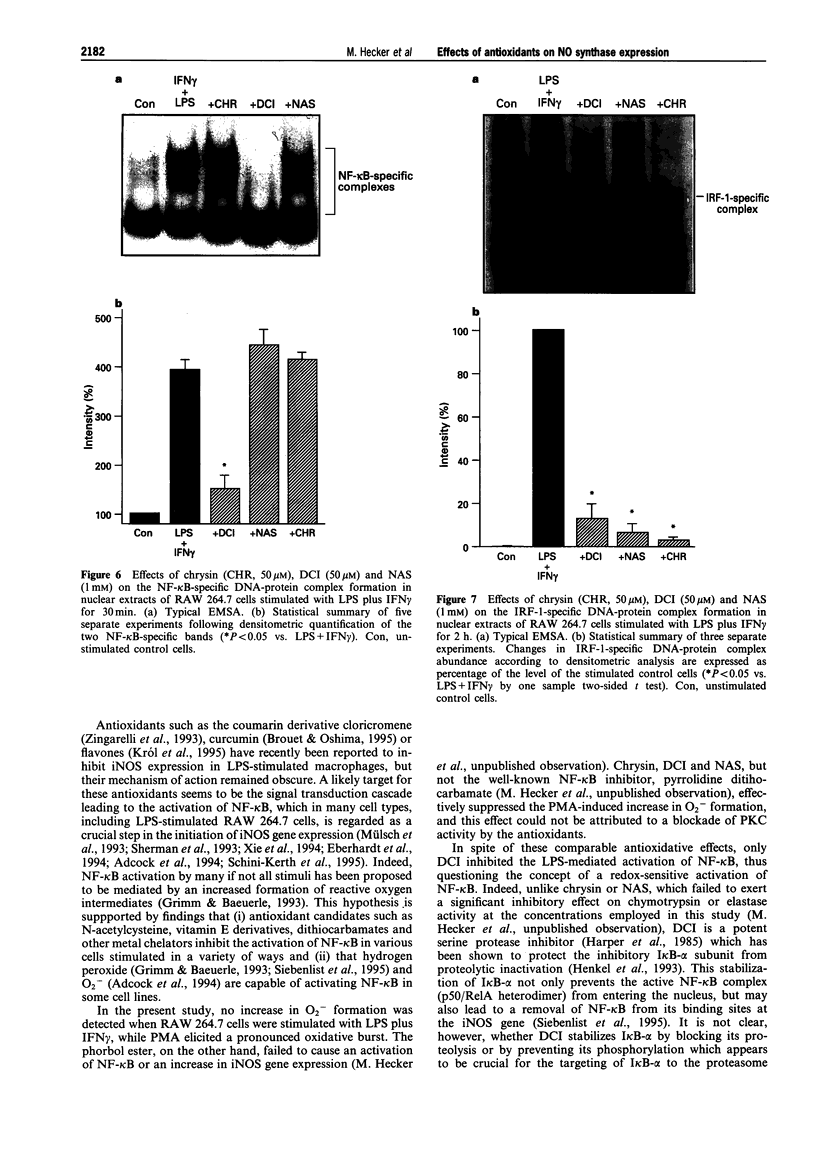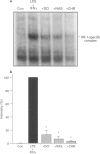Abstract
1. In view of the potential deleterious effects of high amounts of nitric oxide (NO) produced by the inducible isoform of NO synthase (iNOS) in inflammation, the prevention of the expression of this enzyme represents an important therapeutic goal. In cytokine-stimulated cells, activation of nuclear factor kappa B (NF-kappa B) is crucial for the increase in iNOS gene expression. Since NF-kappa B activation appears to involve a redox-sensitive step, we have investigated whether three structurally unrelated antioxidants, 5,7-dihydroxyflavone (chrysin), 3,4-dichloroisocoumarin (DCI) and N-acetyl 5-hydroxytryptamine (N-acetylserotonin, NAS), affect iNOS expression in cultured RAW 264.7 monocyte/macrophages stimulated with bacterial lipopolysaccharide (LPS, 140 ng ml-1) and interferon-gamma (IFN gamma, 5 u ml-1). 2. During a 6 h incubation period neither LPS nor IFN gamma alone exerted a significant effect but when combined, caused a prominent increase in nitrite formation, iNOS mRNA and protein abundance. Co-incubation with chrysin (50 microM), DCI (50 microM) or NAS (1 mM) markedly attenuated this increase in iNOS gene expression. 3. DCI, but not chrysin or NAS, prevented the activation of NF-kappa B in cells exposed to LPS plus IFN gamma for 30 min. In contrast, all three antioxidants significantly blunted the DNA-binding activity of interferon regulatory factor 1 (IRF-1), which mediates the synergistic effect of IFN gamma on iNOS gene expression in cells treated for 2 h with LPS plus IFN gamma. 4. DCI thus appears to inhibit iNOS gene expression at the transcriptional level by preventing the activation of both NF-kappa B and IRF-1. The inhibitory effect of DCI on NF-kappa B activation, however, does not seem to be related to its antioxidative properties, since DCI, unlike chrysin or NAS, is a potent serine protease inhibitor which stabilizes the inactive NF-kappa B complex by protecting the inhibitory I kappa B-alpha subunit from proteolytic degradation. 5. The virtually identical inhibitory effect of chrysin, DCI and NAS on the activation of IRF-1 points to a redox-sensitive step in the activation of this transcription factor, which in contrast to NF-kappa B requires de novo protein synthesis. 6. Since iNOS gene expression in human cells and tissues usually requires the combination of several cytokines, antioxidants such as chrysin and NAS which do not interfere with the activation of NF-kappa B may be of therapeutic value for selectively inhibiting the enhanced expression of this enzyme in inflammation.
Full text
PDF






Images in this article
Selected References
These references are in PubMed. This may not be the complete list of references from this article.
- Adcock I. M., Brown C. R., Kwon O., Barnes P. J. Oxidative stress induces NF kappa B DNA binding and inducible NOS mRNA in human epithelial cells. Biochem Biophys Res Commun. 1994 Mar 30;199(3):1518–1524. doi: 10.1006/bbrc.1994.1403. [DOI] [PubMed] [Google Scholar]
- Brouet I., Ohshima H. Curcumin, an anti-tumour promoter and anti-inflammatory agent, inhibits induction of nitric oxide synthase in activated macrophages. Biochem Biophys Res Commun. 1995 Jan 17;206(2):533–540. doi: 10.1006/bbrc.1995.1076. [DOI] [PubMed] [Google Scholar]
- Chartrain N. A., Geller D. A., Koty P. P., Sitrin N. F., Nussler A. K., Hoffman E. P., Billiar T. R., Hutchinson N. I., Mudgett J. S. Molecular cloning, structure, and chromosomal localization of the human inducible nitric oxide synthase gene. J Biol Chem. 1994 Mar 4;269(9):6765–6772. [PubMed] [Google Scholar]
- Chomczynski P., Sacchi N. Single-step method of RNA isolation by acid guanidinium thiocyanate-phenol-chloroform extraction. Anal Biochem. 1987 Apr;162(1):156–159. doi: 10.1006/abio.1987.9999. [DOI] [PubMed] [Google Scholar]
- Collins T., Read M. A., Neish A. S., Whitley M. Z., Thanos D., Maniatis T. Transcriptional regulation of endothelial cell adhesion molecules: NF-kappa B and cytokine-inducible enhancers. FASEB J. 1995 Jul;9(10):899–909. [PubMed] [Google Scholar]
- Eberhardt W., Kunz D., Pfeilschifter J. Pyrrolidine dithiocarbamate differentially affects interleukin 1 beta- and cAMP-induced nitric oxide synthase expression in rat renal mesangial cells. Biochem Biophys Res Commun. 1994 Apr 15;200(1):163–170. doi: 10.1006/bbrc.1994.1429. [DOI] [PubMed] [Google Scholar]
- Feinberg A. P., Vogelstein B. A technique for radiolabeling DNA restriction endonuclease fragments to high specific activity. Anal Biochem. 1983 Jul 1;132(1):6–13. doi: 10.1016/0003-2697(83)90418-9. [DOI] [PubMed] [Google Scholar]
- Finco T. S., Beg A. A., Baldwin A. S., Jr Inducible phosphorylation of I kappa B alpha is not sufficient for its dissociation from NF-kappa B and is inhibited by protease inhibitors. Proc Natl Acad Sci U S A. 1994 Dec 6;91(25):11884–11888. doi: 10.1073/pnas.91.25.11884. [DOI] [PMC free article] [PubMed] [Google Scholar]
- Goldring C. E., Narayanan R., Lagadec P., Jeannin J. F. Transcriptional inhibition of the inducible nitric oxide synthase gene by competitive binding of NF-kappa B/Rel proteins. Biochem Biophys Res Commun. 1995 Apr 6;209(1):73–79. doi: 10.1006/bbrc.1995.1472. [DOI] [PubMed] [Google Scholar]
- Grimm S., Baeuerle P. A. The inducible transcription factor NF-kappa B: structure-function relationship of its protein subunits. Biochem J. 1993 Mar 1;290(Pt 2):297–308. doi: 10.1042/bj2900297. [DOI] [PMC free article] [PubMed] [Google Scholar]
- Harada H., Willison K., Sakakibara J., Miyamoto M., Fujita T., Taniguchi T. Absence of the type I IFN system in EC cells: transcriptional activator (IRF-1) and repressor (IRF-2) genes are developmentally regulated. Cell. 1990 Oct 19;63(2):303–312. doi: 10.1016/0092-8674(90)90163-9. [DOI] [PubMed] [Google Scholar]
- Harper J. W., Hemmi K., Powers J. C. Reaction of serine proteases with substituted isocoumarins: discovery of 3,4-dichloroisocoumarin, a new general mechanism based serine protease inhibitor. Biochemistry. 1985 Apr 9;24(8):1831–1841. doi: 10.1021/bi00329a005. [DOI] [PubMed] [Google Scholar]
- Hecker M., Mülsch A., Bassenge E., Förstermann U., Busse R. Subcellular localization and characterization of nitric oxide synthase(s) in endothelial cells: physiological implications. Biochem J. 1994 Apr 1;299(Pt 1):247–252. doi: 10.1042/bj2990247. [DOI] [PMC free article] [PubMed] [Google Scholar]
- Henkel T., Machleidt T., Alkalay I., Krönke M., Ben-Neriah Y., Baeuerle P. A. Rapid proteolysis of I kappa B-alpha is necessary for activation of transcription factor NF-kappa B. Nature. 1993 Sep 9;365(6442):182–185. doi: 10.1038/365182a0. [DOI] [PubMed] [Google Scholar]
- Kamijo R., Harada H., Matsuyama T., Bosland M., Gerecitano J., Shapiro D., Le J., Koh S. I., Kimura T., Green S. J. Requirement for transcription factor IRF-1 in NO synthase induction in macrophages. Science. 1994 Mar 18;263(5153):1612–1615. doi: 10.1126/science.7510419. [DOI] [PubMed] [Google Scholar]
- Król W., Czuba Z. P., Threadgill M. D., Cunningham B. D., Pietsz G. Inhibition of nitric oxide (NO.) production in murine macrophages by flavones. Biochem Pharmacol. 1995 Sep 28;50(7):1031–1035. doi: 10.1016/0006-2952(95)00237-t. [DOI] [PubMed] [Google Scholar]
- Lorsbach R. B., Murphy W. J., Lowenstein C. J., Snyder S. H., Russell S. W. Expression of the nitric oxide synthase gene in mouse macrophages activated for tumor cell killing. Molecular basis for the synergy between interferon-gamma and lipopolysaccharide. J Biol Chem. 1993 Jan 25;268(3):1908–1913. [PubMed] [Google Scholar]
- Lowenstein C. J., Alley E. W., Raval P., Snowman A. M., Snyder S. H., Russell S. W., Murphy W. J. Macrophage nitric oxide synthase gene: two upstream regions mediate induction by interferon gamma and lipopolysaccharide. Proc Natl Acad Sci U S A. 1993 Oct 15;90(20):9730–9734. doi: 10.1073/pnas.90.20.9730. [DOI] [PMC free article] [PubMed] [Google Scholar]
- Martin E., Nathan C., Xie Q. W. Role of interferon regulatory factor 1 in induction of nitric oxide synthase. J Exp Med. 1994 Sep 1;180(3):977–984. doi: 10.1084/jem.180.3.977. [DOI] [PMC free article] [PubMed] [Google Scholar]
- Morris S. M., Jr, Billiar T. R. New insights into the regulation of inducible nitric oxide synthesis. Am J Physiol. 1994 Jun;266(6 Pt 1):E829–E839. doi: 10.1152/ajpendo.1994.266.6.E829. [DOI] [PubMed] [Google Scholar]
- Mülsch A., Schray-Utz B., Mordvintcev P. I., Hauschildt S., Busse R. Diethyldithiocarbamate inhibits induction of macrophage NO synthase. FEBS Lett. 1993 Apr 26;321(2-3):215–218. doi: 10.1016/0014-5793(93)80111-7. [DOI] [PubMed] [Google Scholar]
- Ohara Y., Peterson T. E., Harrison D. G. Hypercholesterolemia increases endothelial superoxide anion production. J Clin Invest. 1993 Jun;91(6):2546–2551. doi: 10.1172/JCI116491. [DOI] [PMC free article] [PubMed] [Google Scholar]
- Schini-Kerth V., Bara A., Mülsch A., Busse R. Pyrrolidine dithiocarbamate selectively prevents the expression of the inducible nitric oxide synthase in the rat aorta. Eur J Pharmacol. 1994 Nov 14;265(1-2):83–87. doi: 10.1016/0014-2999(94)90226-7. [DOI] [PubMed] [Google Scholar]
- Schreiber E., Matthias P., Müller M. M., Schaffner W. Rapid detection of octamer binding proteins with 'mini-extracts', prepared from a small number of cells. Nucleic Acids Res. 1989 Aug 11;17(15):6419–6419. doi: 10.1093/nar/17.15.6419. [DOI] [PMC free article] [PubMed] [Google Scholar]
- Sherman M. P., Aeberhard E. E., Wong V. Z., Griscavage J. M., Ignarro L. J. Pyrrolidine dithiocarbamate inhibits induction of nitric oxide synthase activity in rat alveolar macrophages. Biochem Biophys Res Commun. 1993 Mar 31;191(3):1301–1308. doi: 10.1006/bbrc.1993.1359. [DOI] [PubMed] [Google Scholar]
- Xie Q. W., Kashiwabara Y., Nathan C. Role of transcription factor NF-kappa B/Rel in induction of nitric oxide synthase. J Biol Chem. 1994 Feb 18;269(7):4705–4708. [PubMed] [Google Scholar]
- Xie Q. W., Whisnant R., Nathan C. Promoter of the mouse gene encoding calcium-independent nitric oxide synthase confers inducibility by interferon gamma and bacterial lipopolysaccharide. J Exp Med. 1993 Jun 1;177(6):1779–1784. doi: 10.1084/jem.177.6.1779. [DOI] [PMC free article] [PubMed] [Google Scholar]
- Zingarelli B., Carnuccio R., Di Rosa M. Cloricromene inhibits the induction of nitric oxide synthase. Eur J Pharmacol. 1993 Oct 19;243(2):107–111. doi: 10.1016/0014-2999(93)90368-r. [DOI] [PubMed] [Google Scholar]





